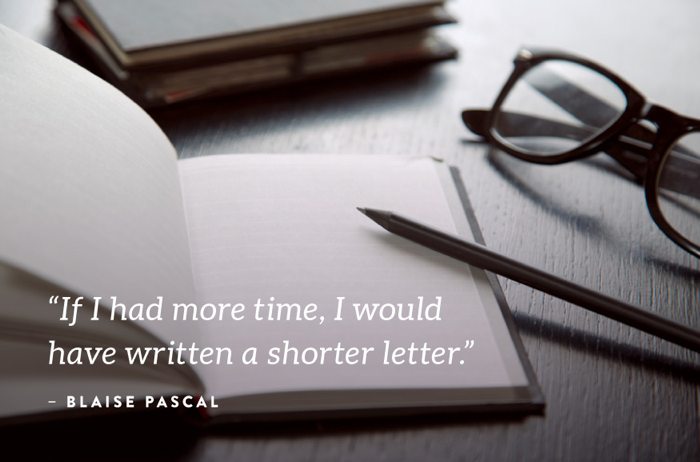
Good writing starts with a plan. It wastes no words. It embraces revision.
And it may even keep you from being rendered redundant.
It happens to everyone: You face a blank computer screen with an important message to share. And a fog descends.
Whether the challenge is a meeting report or a project proposal, an important email or announcement of staff changes, you pause and struggle for the right words.
Where to start? How to make key points clearly? And meanwhile … time is ticking away at your day’s to-do list.
Betty Sue Flowers, a professor emeritus at University of Texas, has a great strategy for you.
She describes the process of writing with four roles you assume in sequence:
First, the madman. You get all your ideas out, no editing allowed.
Second, the architect. You come up with an overall structure.
Third, the carpenter. You hammer together ideas and examples.
Finally, the judge. You revise and edit.
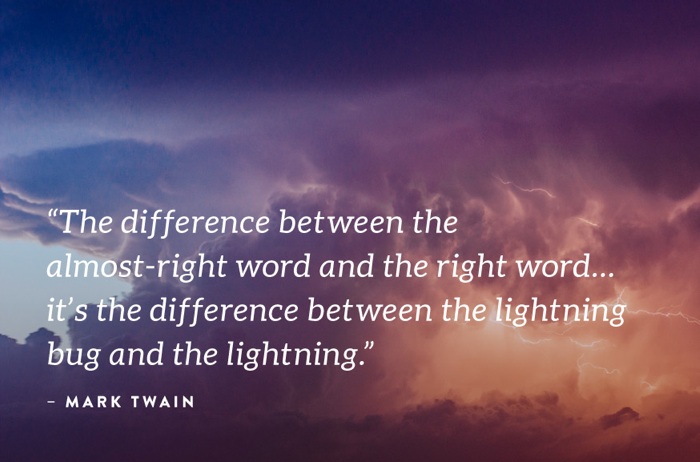
Her process is the perfect antidote to writer’s block – and underscores the most important point about writing better: Effective writing is rarely the product of lightning-bolt inspiration. It reflects careful thinking about your message and your audience. And it requires structure and language that ease the way for your reader.
In these days of far-flung organization operations, short attention spans, diverse audiences and multiple modes of communication, it has never been more important to express yourself in writing clearly and succinctly – and with emotional intelligence.
The kicker? You probably haven’t had a good conversation or seminar about writing since college – long before texts, tweets, posts, blogs, emails, and online digests transformed the communication landscape.
So here’s a little help — 12 tips assembled by The Wunderlin Company team to get you thinking about writing better in a contemporary way, including a few key notes about email.
Added perspective comes from my friend and neighbor Garrison Cox, who has served an editor, writer and readability expert in varied corporate and nonprofit settings.
His business card says: “What you mean to say, expressed clearly.” He sometimes tells people, “I create order out of chaos with words.”
1. 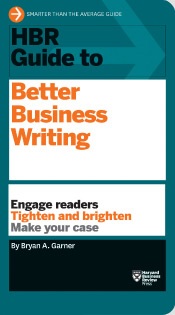 Nail your message. To be perfectly clear, write it in a crisp, carefully constructed sentence or two. Whether it is an email to your boss, an announcement to 400 professional colleagues, a short speech or an updated LinkedIn profile, distilling your message will prepare you to say it up front.
Nail your message. To be perfectly clear, write it in a crisp, carefully constructed sentence or two. Whether it is an email to your boss, an announcement to 400 professional colleagues, a short speech or an updated LinkedIn profile, distilling your message will prepare you to say it up front.
2. Say it up front. That is, make your main point at the very start of your writing, says Bryan A. Garner, an ace writing resource whose many books include: “HBR Guide to Better Business Writing: Engage readers. Tighten and brighten. Make your case.” The title meets the test.
3. Know your audience. Is it an informal note to a few close colleagues? Is it a rare note to a larger group that doesn’t know you well? Imagine different readers, what they need to know and how they might respond. Adjust language and tone accordingly.
4. Create a clear, logical structure. Garrison Cox likes to ask: “What? So what? Now what?” a format that focuses on what you have to say, why it matters and how it will shape work going forward. Chronological order makes sense, if relevant. Bullet points, bold-face type, numbered lists and boxed supplementary material all help readers navigate.
5. Short is sweet. Short words, short sentences, short paragraphs and white space improve readability. With extra verbiage stripped away, your message is likelier to be heard and understood. At the same time, short doesn’t mean you leave out critical information, fail to provide context or announce layoffs in three sentences.
6. 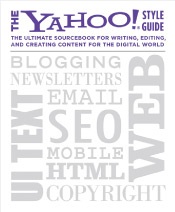 Put it on a word diet. Never has it been easier to pare away as we edit on our computer screens. Cut the phrase “has proven to be,” for example, and instead say “is.” Trim “
Put it on a word diet. Never has it been easier to pare away as we edit on our computer screens. Cut the phrase “has proven to be,” for example, and instead say “is.” Trim “in conjunction with.” Cut “advance planning.” “The Yahoo! Style Guide” is a first-rate writing resource with special emphasis on content for the digital world, offers eight pages of “extraneous words, redundancy and pretentious vocabulary.” Every one of us has used them. Time to let ‘em go. Liz Cornish, a member of the Wunderlin Company team and author of a new book “Pass It On: Priceless Advice from Highly Successful Women” uses the term “verbal noise” to describe useless words that distract from your message.
7. Use strong, direct language. Strong language means active voice, so it’s clear who did what: Not “mistakes were made, but “I forgot to book the reservation.” Strong verbs propel sentences forward better than adjectives and adverbs. Avoid business jargon, says Garner: “You want to sound like a person, not an institution.” He offers three pages of words and phrases to avoid – terms like “client-centered,” “guesstimate” and “”think outside the box.” Check out his “blacklist” in this Harvard Business Review blog. Other language and punctuation sand traps to avoid: acronyms, slang, texting abbreviations, empty language like “etcetera,” (unnecessary) parentheticals and reckless use of capitalization and exclamation points.
8. 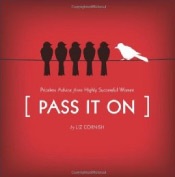 Master email. Odds are you spend more than a quarter of your work time writing and reading email, says a report by McKinsey & Co. To stay productive, keep it short – one screen. If longer, write a document to attach. Use bullets and bold type to highlight key points. Make the most of an e-mail subject line to help recipients sort by topic and urgency. For example: “Bring a new mindset to performance reviews” or “Deadline change: Need memo by afternoon meeting.” Copy only the most relevant people. Don’t “Reply to all” unless necessary. Think carefully about forwarding email strings with vague directions like “Your thoughts?” In an HBR blog, David Silverman says that’s translates to: “I can’t be bothered to explain my reasoning or what I want you to focus on.”
Master email. Odds are you spend more than a quarter of your work time writing and reading email, says a report by McKinsey & Co. To stay productive, keep it short – one screen. If longer, write a document to attach. Use bullets and bold type to highlight key points. Make the most of an e-mail subject line to help recipients sort by topic and urgency. For example: “Bring a new mindset to performance reviews” or “Deadline change: Need memo by afternoon meeting.” Copy only the most relevant people. Don’t “Reply to all” unless necessary. Think carefully about forwarding email strings with vague directions like “Your thoughts?” In an HBR blog, David Silverman says that’s translates to: “I can’t be bothered to explain my reasoning or what I want you to focus on.”
9. Know when NOT to write. Do you have feedback for a colleague? Something private to say? Are emails or texts flying so fast that you are losing the thread? Do you need a more personal reading of the situation? Is the emotional tenor is important? Is subtext or context being lost? Stop. Pick up the phone. Walk down the hall. Meet face-to-face.
10. Chill overnight. If a report, evaluation, speech or message is important, take a break and review it with fresh eyes the next day – the judge’s eyes, as Betty Sue Flowers might say. For flow and clarity, consider reading it out loud. Think one last time about your audience and questions and reactions that might arise.
11. Get a writing guide. I recommend two kinds: first, written guides. The Yahoo! And Garner guides are first-rate. See fuller list below. With a dictionary and a thesaurus, they will tell you whether to use an apostrophe in “its,” include a hyphen in email or choose “illicit” and “elicit.” Having a human writing guide is a good idea as well – a colleague or friend who will read your writing and offer an honest second opinion on tone, clarity, context and usage mistakes that will never show up on spell-check. A coworker of mine caught a misspelling of “vocation” as “vacation” — and an embarrassment was averted. If you think a one-on-one writing coach would help you or your team, consider hiring someone for a few customized sessions.
12. Revive the handwritten note. If you want to say thanks for a recommendation, send a note of condolence or congratulate a friend on a new job, pick up a pen and stationery: A short hand-written note stands out from the crowd. It can be three short, sincere sentences. The impact? A colleague left a government job a few years ago and wrote personalized cards to say “Thanks. I learned a lot from you” – with an example – to a couple dozen coworkers. Those notes were still propped up on desks a year later.

How about you?
What writing challenges have you encountered? What strategies have helped?
Do you make good writing a priority in your workplace? If so, how do you help colleagues improve their skill?
Drop me a line at kw@wunderlin.com
Resources
I haven’t dwelled on details of grammar and usage because good books have the space and expertise to help. Your field may rely on certain reference book as its preferred style guide.
Besides the HBR and Yahoo! Guides:
“The Elements of Style,” by William Strunk Jr. and E.B. White, has been the regularly revised go-to book for writing clearly for more than 50 years.
“The Chicago Manual of Style,” available free online
“The Associated Press Stylebook,” the standard for most newspaper use.
Five HBR blog postings can give you a free taste of Brian Garner’s perspective: A Q-and-A, overall writing advice, email suggestions; avoiding grammar gaffes and composing effective business letters.
For a lively list of 10 tips for writing well, read this memo by advertising icon David Ogilvy that starts out with, “The better you write, the higher you go …” and includes “People who think well, write well.”
To get motivated about grammar, read this HBR article, which starts out “If you think an apostrophe was one of the 12 disciples of Jesus, you will never work for me.” Its author, Kyle Wiens, CEO of iFixit, argues that careless writing correlates with lack of care on the job.
And speaking of apostrophes….Misuse is rampant and a pet peeve of many folks. This website aims to help and also document apostrophe abuse.
Finally, for a chuckle, check out this Harvard Graduate School of Education cartoon about Betty Sue Flowers classic writing paradigm.


Excellent, a great guide and checklist for writing, I plan to keep a copy next to my desk!
This was great! I love the word diet section. We all try to sound so fancy and we just end up using extra words. So many in fact that the message is often lost. I have already shared this with my team.
Thanks!